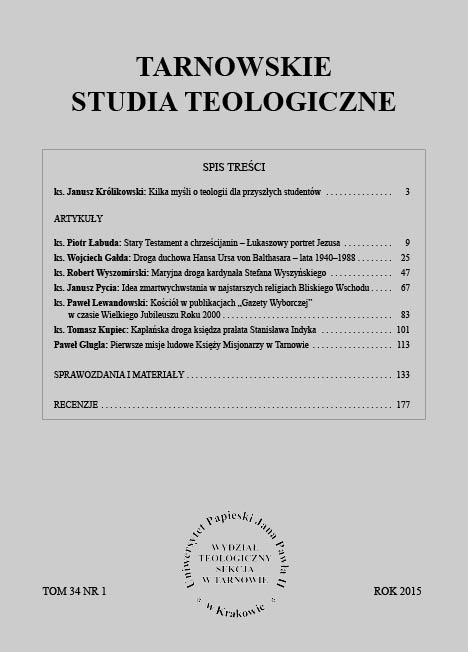The idea of resurrection in the religions of the Middle East
DOI:
https://doi.org/10.15633/tst.1564Keywords:
the resurrection, life after death, the culture of Mesopotamia, culture Egyptian, culture Phoenicians, Persian religion, the zoroastrianismAbstract
The purpose of this essay is to present the idea of the resurrection in the major cultures of the Middle East. In its presentation was used a reference to the biblical tradition that shows the similarities rather than the genealogy of the biblical eschatological thought. In the presentation of the culture of Mesopotamia it is noticed some exclusivism, as for the issue of immortality, which was participated only by a few, however, some kind of existence of dead in underworld was assumed.
Certain development of the idea brings the Egyptian and the Persian culture, introducing motives of journey of dead and the posthumous court as a moral evaluation of earthly life, as well as, the possibility of attainment an honor to be in presence of gods, as a reward for an honest life. All cultures, however, not excluding the Phoenician, characterize a belief in the necessity of the burial of the human body, as one of the conditions for peace of soul of the dead.
References
Arnold S., Kurkiewicz W., Tatomir A., Żurawski W., Dzieje świata. Chronologiczny przegląd wydarzeń, Warszawa 1990.
Baran G. M., Los człowieka po śmierci w wierzeniach ludów ościennych dawnego Izraela, „Scripturae Lumen” 2010 nr 2, s. 137–160.
Bartnik C. S., Dogmatyka katolicka, t. 1, Lublin 1999.
Boyce M., Ahura Mazda, [w:] Encyclopaedia Iranica, ed. E. Yarshater, t. 1, London 1985.
Bravo B., Wipszycka E., Historia starożytnych Greków. Okres hellenistyczny, t. 3, Warszawa 1992.
Ćwiek A., Religia Egiptu, [w:] Religie starożytnego Bliskiego Wschodu, red. K. Pilarczyk, J. Drabina, Kraków 2008, s. 27–176.
Fenicja, red. P. Juszczak, Warszawa 2007 (Mitologie Świata).
Gilgamesz. Epos starożytnego Dwurzecza, tł. R. Stiller, Warszawa 1980.
Golzio K. H., Der Tempel im Alten Mesopotamien und Seine Parallelen in Indien. Eine Religionshistorische Studie, Hamburg 1983 (Beihefte der Zeitschrift für Religions und Religionsgeschichte, 25).
Grimal N., Dzieje starożytnego Egiptu, Warszawa 2004.
Gurney O. R., The Sultantepe tablets (continued), VII: The myth of Nergal and Ereshkigal, „Anatolian Studies” 10 (1960), s. 105–131.
Herodot, Dzieje, tł. S. Hammer, Warszawa 1959.
Hudzikowski M., Religie starożytnej Persji, 28.04.2014, http://geopolityka.net/religie-starozytnej-persji (28.04.2014).
Jakubiak K., Religia Iranu, [w:] Religie starożytnego Bliskiego Wschodu, red. K. Pilarczyk, J. Drabina, Kraków 2008.
Jelonek T., Kultura Mezopotamska a Biblia, Kraków 2009.
Jelonek T., Kultura Perska a Biblia, Kraków 2010.
Kemp B. J., Starożytny Egipt. Anatomia cywilizacji, tł. J. Aksamit, Warszawa 2009.
Leligdowicz A., Scytowie, Warszawa 2002 (Starożytne Cywilizacje: podróż przez tysiąclecia, 51).
Marciniak M., Historia starożytnego Egiptu, [w:] Starożytny Egipt, red. A. Szczudłowska, Warszawa 1978.
Mrozewicz L., Historia powszechna. Starożytność, Poznań 1999.
Religie świata. Encyklopedia, red. J. Rawicz, Kraków 2005.
Shaw I., The Oxford history of ancient Egypt, Oxford 2000.
Sidor K., Bogowie, magowie i nafta, Warszawa 1971.
Składankowa M., Mitologia Iranu, Warszawa 1989.
Sołtysiak A., Religie Mezopotamii, [w:] Religie starożytnego Bliskiego Wschodu, red. K. Pilarczyk, J. Drabina, Kraków 2008, s. 111–176.
Starożytni Egipcjanie, red. J. Cieślewska, Warszawa 2007 (Mitologie Świata).
Tschirschnitz A., Dzieje ludów biblijnych, cz. VI: Dzieje państw i plemion starożytnej Syrii i Palestyny, Warszawa 1994.
Wesendonk O. G. von, Das Weltbild der Iranier, München 1933.
Wilkinson T. A. H., Early dynastic Egypt, London, New York 1999.
Zinkow L., Imhotep – „Twórca cywilizacji”, „Episteme. Czasopismo Naukowo-Kulturalne” 2012 nr 16 t. 1, s. 5–20.
Zmartwychwstanie w mitach i religiach, http://www.opoczno-top.pl/artykul,Zmartwychwstanie_w_mitach_i_religiach,11998.html (02.05.2014), (artykuł ukazał się również w wydaniu nr 13 [820] „Tygodnika Opoczyńskiego” 29.03.2013).
Downloads
Published
Issue
Section
License
Authors who publish with this journal agree to the following terms:
- Authors retain the copyright and full publishing rights without restrictions, and grant the journal right of first publication with the work simultaneously licensed under a Creative Commons Attribution 4.0 International License that allows others to share the work with an acknowledgement of the work's authorship and initial publication in this journal.
- Authors are able to enter into separate, additional contractual arrangements for the non-exclusive distribution of the journal's published version of the work (e.g., post it to an institutional repository or publish it in a book), with an acknowledgement of its initial publication in this journal.
- Authors are permitted and encouraged to post their work online (e.g., in institutional repositories or on their website) prior to and during the submission process, as it can lead to productive exchanges, as well as earlier and greater citation of published work (See The Effect of Open Access).

